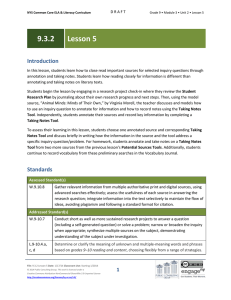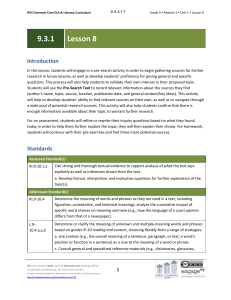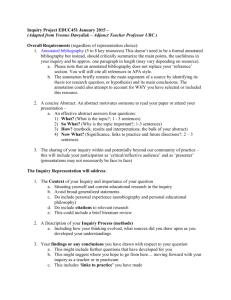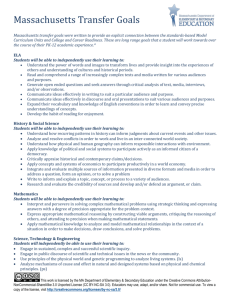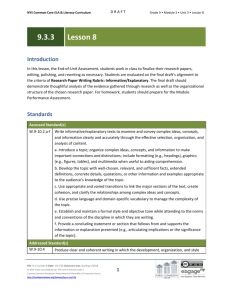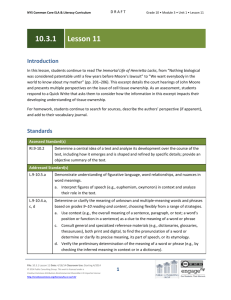Learning Sequence
advertisement
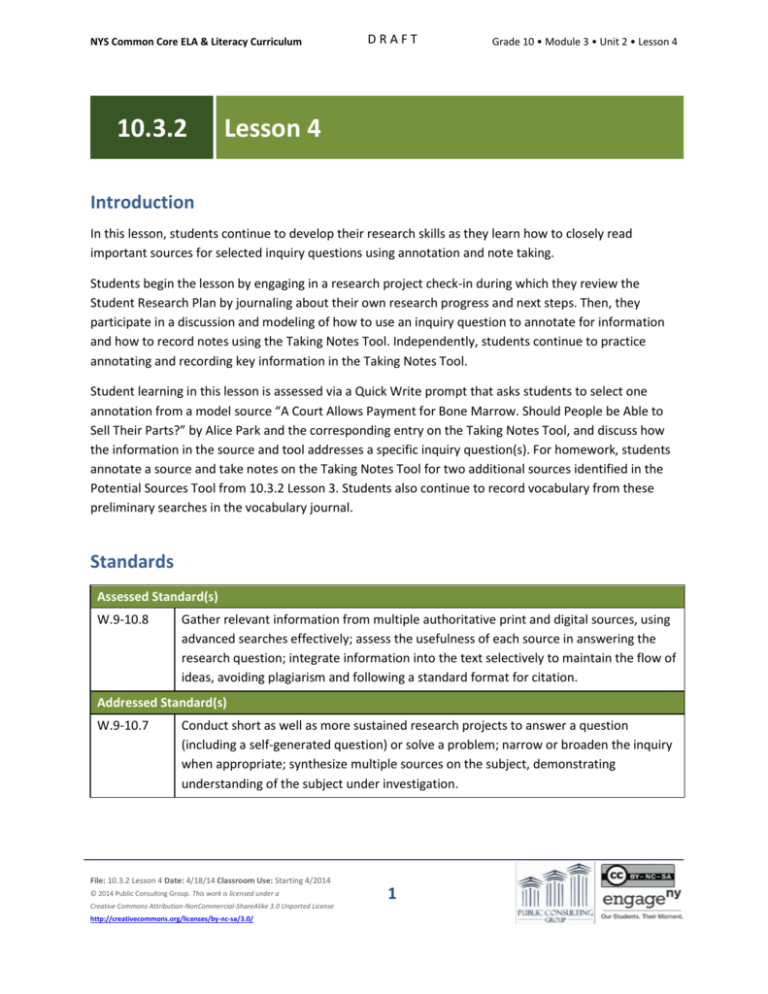
NYS Common Core ELA & Literacy Curriculum 10.3.2 DRAFT Grade 10 • Module 3 • Unit 2 • Lesson 4 Lesson 4 Introduction In this lesson, students continue to develop their research skills as they learn how to closely read important sources for selected inquiry questions using annotation and note taking. Students begin the lesson by engaging in a research project check-in during which they review the Student Research Plan by journaling about their own research progress and next steps. Then, they participate in a discussion and modeling of how to use an inquiry question to annotate for information and how to record notes using the Taking Notes Tool. Independently, students continue to practice annotating and recording key information in the Taking Notes Tool. Student learning in this lesson is assessed via a Quick Write prompt that asks students to select one annotation from a model source “A Court Allows Payment for Bone Marrow. Should People be Able to Sell Their Parts?” by Alice Park and the corresponding entry on the Taking Notes Tool, and discuss how the information in the source and tool addresses a specific inquiry question(s). For homework, students annotate a source and take notes on the Taking Notes Tool for two additional sources identified in the Potential Sources Tool from 10.3.2 Lesson 3. Students also continue to record vocabulary from these preliminary searches in the vocabulary journal. Standards Assessed Standard(s) W.9-10.8 Gather relevant information from multiple authoritative print and digital sources, using advanced searches effectively; assess the usefulness of each source in answering the research question; integrate information into the text selectively to maintain the flow of ideas, avoiding plagiarism and following a standard format for citation. Addressed Standard(s) W.9-10.7 Conduct short as well as more sustained research projects to answer a question (including a self-generated question) or solve a problem; narrow or broaden the inquiry when appropriate; synthesize multiple sources on the subject, demonstrating understanding of the subject under investigation. File: 10.3.2 Lesson 4 Date: 4/18/14 Classroom Use: Starting 4/2014 © 2014 Public Consulting Group. This work is licensed under a Creative Commons Attribution-NonCommercial-ShareAlike 3.0 Unported License http://creativecommons.org/licenses/by-nc-sa/3.0/ 1 NYS Common Core ELA & Literacy Curriculum DRAFT Grade 10 • Module 3 • Unit 2 • Lesson 4 Assessment Assessment(s) Student learning is assessed via a Quick Write at the end of the lesson. Students respond to the following prompt, citing textual evidence to support analysis and inferences drawn from the text. Choose one of your independent annotations from the model source and the corresponding entry on the Taking Notes Tool and discuss how the information in the source and tool address a specific inquiry question(s). High Performance Response(s) A High Performance Response should: Cite an annotation (e.g., an underline beneath the sentence “A U.S. appeals court puts the price at about $3,000 in a ruling that now makes it legal to pay donors for their bone marrow tissue” and its corresponding Taking Notes Tool entry). Identify a specific inquiry question (e.g., “Who should own tissue once it is surgically removed from the body?”). Discuss the connection(s) between the annotation, the Taking Notes Tool entry, and the specific inquiry question (e.g., “By allowing individuals to be paid for their bone marrow tissue, this reference from the model source shows the establishment of a legal precedent for tissue ownership. If individuals can be compensated for their tissue, then logically, the court is saying that they own their tissue.”). Vocabulary Vocabulary to provide directly (will not include extended instruction) None.* Vocabulary to teach (may include direct word work and/or questions) None.* *In their research and reading, students will encounter domain-specific vocabulary related to their individual research questions/problems. Students will track some of this vocabulary in their vocabulary journals when conducting independent searches during class and for homework. File: 10.3.2 Lesson 4 Date: 4/18/14 Classroom Use: Starting 4/2014 © 2014 Public Consulting Group. This work is licensed under a Creative Commons Attribution-NonCommercial-ShareAlike 3.0 Unported License http://creativecommons.org/licenses/by-nc-sa/3.0/ 2 NYS Common Core ELA & Literacy Curriculum DRAFT Grade 10 • Module 3 • Unit 2 • Lesson 4 Lesson Agenda/Overview Student-Facing Agenda % of Lesson Standards & Text: Standards: W.9-10.8, W.9-10.7 Model Source Text: “A Court Allows Payment for Bone Marrow. Should People be Able to Sell Their Parts?” by Alice Park Learning Sequence: 1. 2. 3. 4. 5. 6. Introduction of Lesson Agenda Homework Accountability and Research Check-In Annotating Sources and Taking Notes Annotating Sources and Taking Notes Independently Quick Write Closing Materials Student copies of the Potential Sources Tool (refer to 10.3.2 Lesson 3) Student copies of the Assessing Sources Handout (refer to 10.3.2 Lesson 3) Research Portfolios (refer to 10.3.2 Lesson 1) Student copies of the Student Research Plan (refer to 10.3.2 Lesson 2) Copies of the Taking Notes Tool for each student Learning Sequence How to Use the Learning Sequence Symbol 10% Type of Text & Interpretation of the Symbol Percentage indicates the percentage of lesson time each activity should take. Plain text indicates teacher action. Bold text indicates questions for the teacher to ask students. Italicized text indicates a vocabulary word. Indicates student action(s). Indicates possible student response(s) to teacher questions. Indicates instructional notes for the teacher. no symbol File: 10.3.2 Lesson 4 Date: 4/18/14 Classroom Use: Starting 4/2014 © 2014 Public Consulting Group. This work is licensed under a Creative Commons Attribution-NonCommercial-ShareAlike 3.0 Unported License http://creativecommons.org/licenses/by-nc-sa/3.0/ 3 1. 2. 3. 4. 5. 6. 5% 15% 35% 30% 10% 5% NYS Common Core ELA & Literacy Curriculum DRAFT Grade 10 • Module 3 • Unit 2 • Lesson 4 Activity 1: Introduction of Lesson Agenda 5% Begin by reviewing the agenda and the assessed standard for this lesson: W.9-10.8. Explain that students begin the lesson by engaging in a research project check-in, during which they review the Student Research Plan by journaling about their own research progress and next steps. Using a model source, discuss and model how to use an inquiry question to annotate for information, including how to record notes using the Taking Notes Tool. Independently, students annotate a model source and record key information by completing a Taking Notes Tool. Students look at the agenda. Activity 2: Homework Accountability and Research Check-In 15% Instruct students to take out their homework from 10.3.2 Lesson 3. Instruct students to discuss in pairs how two of the additional sources they found meet the criteria for being credible, accessible, and relevant. Student responses vary depending on their individual search experience but should clearly articulate why two sources are high quality based on their ratings on the Potential Sources Tool. Student responses should use the language of the Assessing Sources Handout. Lead a brief share out of student pair discussion. Consider collecting the homework to monitor students’ research progress. Distribute the assessment and feedback from 10.3.2 Lesson 3. Instruct students to review teacher comments. Students examine the teacher’s feedback. Ask students to take out the Student Research Plan from their Research Portfolios. The Student Research Plan should be located in the front of each student’s Research Portfolio. Instruct students to review the Student Research Plan, Part 2, regarding the finding and assessing sources skills and examine the part of W.9-10.8 that corresponds to this process: “Gather relevant information from multiple authoritative print and digital sources, using advanced searches effectively; assess the usefulness of each source in answering the research question.” Instruct students to use the homework from 10.3.2 Lesson 3 and the language of W.9-10.8. Instruct students to continue the Research Journal started in 10.3.2 Lesson 3; students can write on separate sheets of paper or in a notebook and keep the Research Journal in the Research Portfolio. File: 10.3.2 Lesson 4 Date: 4/18/14 Classroom Use: Starting 4/2014 © 2014 Public Consulting Group. This work is licensed under a Creative Commons Attribution-NonCommercial-ShareAlike 3.0 Unported License http://creativecommons.org/licenses/by-nc-sa/3.0/ 4 NYS Common Core ELA & Literacy Curriculum DRAFT Grade 10 • Module 3 • Unit 2 • Lesson 4 Students review the Student Research Plan and language of W.9-10.8. Student responses vary by individual research topic/area of investigation but should use the language of the Student Research Plan, Part 2 (finding and assessing sources) and the language of W.9-10.8 when reflecting on their research progress and next steps. Instruct students to file the Student Research Plan in the front section of the Research Portfolio and organize the tools from 10.3.2 Lesson 3 in Section 2: Gathering and Analyzing Information. Ask students to keep their Potential Sources Tools from 10.3.2 Lesson 3 out for further reference. Students organize their resources. Activity 3: Annotating Sources and Taking Notes 35% Share with students that once relevant, credible, and accessible sources are identified, the next step in the research process is to read sources closely, with an eye toward selecting sources that further their research and help to answer the inquiry question guiding that specific search process. Students listen. Inform students that reading closely for the purpose of gathering and analyzing information and evidence is done in two steps: annotating and taking notes. Both annotating and taking notes aid in further assessing the usefulness of each source. Students listen. Remind students that a librarian/media specialist can be used as a resource throughout this unit. Explain that annotating involves different actions depending on the type of source. Inform students that the focus text type in this module is informational text for researching argumentation, which necessitates similar annotation to literature but with additional codes. Instruct students that when annotating informational texts they should look for: Key words and concepts Information that answers inquiry questions Initial impressions of the information Areas for possible further exploration Connections to other sources Students listen. Explain that the same annotations used in previous modules are used in this module. Review the annotation codes from the previous modules: File: 10.3.2 Lesson 4 Date: 4/18/14 Classroom Use: Starting 4/2014 © 2014 Public Consulting Group. This work is licensed under a Creative Commons Attribution-NonCommercial-ShareAlike 3.0 Unported License http://creativecommons.org/licenses/by-nc-sa/3.0/ 5 NYS Common Core ELA & Literacy Curriculum DRAFT Grade 10 • Module 3 • Unit 2 • Lesson 4 Put a question mark (?) next to a section you are questioning. Write in the margin or at the top or bottom of the page to record questions (and perhaps answers) that a passage raises in your mind. Use an exclamation point (!) for areas that remind you of another text, strike you in some way, or surprise you. Add an arrow () to make connections between points. Box words and phrases that you do not know or that you find confusing. Rewrite a word or phrase you might have figured out. Star (*) ideas that seem important, or may support your thesis writing later. Use the code CI to indicate a central idea. Students listen. Remind students that in addition to using the codes, it is important that they mark the text with their thoughts as they relate to the codes. Introduce two new annotation codes specifically for informational text: Underline areas that represent major points. If a passage is too long to underline, use vertical lines in the margin. Use numbers in the margin to indicate a sequence of points to trace the development of an argument. Students listen. Consider displaying all annotation codes for students to see. Display the model source: “A Court Allows Payment for Bone Marrow. Should People be Able to Sell Their Parts?” by Alice Park. Read an excerpt of the article aloud from “How much would it take for you to consider selling your bone marrow?” to “Should we allow people to buy and sell human body parts?” (pp. 1–2). Students follow along, reading silently. Ask students to annotate the first three paragraphs of this text excerpt from “How much would it take for you to consider selling your bone marrow” to “The U.S. Court of Appeals for the Ninth Circuit Agreed” (p. 1) for a specific inquiry question: Who should own tissue once it is surgically removed from the body? Model the annotation of the text by coding and writing thoughts directly on the text, pausing after each annotation and explaining the choice. File: 10.3.2 Lesson 4 Date: 4/18/14 Classroom Use: Starting 4/2014 © 2014 Public Consulting Group. This work is licensed under a Creative Commons Attribution-NonCommercial-ShareAlike 3.0 Unported License http://creativecommons.org/licenses/by-nc-sa/3.0/ 6 NYS Common Core ELA & Literacy Curriculum DRAFT Grade 10 • Module 3 • Unit 2 • Lesson 4 Box around marrow because it is a word that may be unfamiliar. Exclamation point and underline the sentence “A U.S. appeals court puts the price at about $3,000 in a ruling that now makes it legal to pay donors for their bone marrow tissue” because the concept of paying someone for their tissue is reminiscent of issues raised in The Immortal Life of Henrietta Lacks and because it represents a major point in the issue of tissue ownership. Exclamation point near the question “What other body parts might be up for sale?” because it brings to mind The Immortal Life of Henrietta Lacks and the fact that her family was never paid for her tissue despite the lucrative business it provided and connects to the question of ownership because whomever owns the tissue can possibly sell it. Underline the phrase “the federal law banning the buying and selling of bodily organs” to acknowledge that a law exists that prevents this, which raises the question of how this law applies to human tissue. Differentiation Consideration: Consider using another model source if this one does not fit individual student or class needs. Instruct students to form small groups of three to four after they have individually read the displayed model text excerpt from “At the core of the plaintiffs’ argument” (p. 1) to “payments for blood or other fluids, such as plasma or semen” (p. 1) and practice annotating the paragraph. Remind students to mark their thinking directly on the source, next to their coding, and to keep the inquiry question in mind as they annotate for information: Who should own tissue once it is surgically removed from the body? Students read and annotate using the model inquiry question. Differentiation Consideration: Consider having students access the model source at http://healthland.time.com/2012/07/02/a-court-allows-payment-for-bone-marrow-should-peoplebe-able-to-sell-their-parts/. Due to the sensitive nature of the model text excerpt, it may be necessary to remind students of norms and expectations when reading these types of academic texts. Consider using a different model text to teach annotation and note taking. Lead a brief share out of the annotation practice to confirm that students identified important details, recorded initial impressions, established connections, and identified other areas of research. Student responses may include: o Vertical line beside the segment that begins with “At the core of the plaintiffs’ argument” and ends with “made marrow donation not much different than donating blood” (p. 1) which denotes a particularly important medical advancement that makes marrow donation very similar to blood donation, and which would place ownership in the hands of donors. File: 10.3.2 Lesson 4 Date: 4/18/14 Classroom Use: Starting 4/2014 © 2014 Public Consulting Group. This work is licensed under a Creative Commons Attribution-NonCommercial-ShareAlike 3.0 Unported License http://creativecommons.org/licenses/by-nc-sa/3.0/ 7 NYS Common Core ELA & Literacy Curriculum o DRAFT Grade 10 • Module 3 • Unit 2 • Lesson 4 Star near the words “marrow cells should be considered a fluid like blood, rather than an organ” (p. 1) which further explains how medical advancements position bone marrow donation in a similar category with blood donation. Explain that the next step in the research process is note taking. Using their annotations as guides, students organize and record information relevant to their research using the Taking Notes Tool. Students listen. Distribute the Taking Notes Tool to each student. Encourage students to examine it and then ask: What is important about the three-column organization of this tool? The three columns help to organize and make the information from the annotations easily accessible for later research. It may be helpful to explain that in the first column, “Ref” is short for “reference.” Explain to students that the richest or most relevant annotations have corresponding entries on the Taking Notes Tool. Instruct students to follow along and fill in their tool while the Taking Notes Tool is modeled. Students follow along and enter the richest or most relevant information on their copy of the Taking Notes Tool. At the top of the tool, ask students to write the inquiry question: “Who should own tissue once it is surgically removed from the body?” Instruct students to record the source number just as it appears on their Potential Sources Tool under the column marked “Ref.” In addition to the Potential Sources Tool source number, explain that the reference column needs to include precise information about where the annotation is located in the actual text. Model this for students by writing “Source #1 and Paragraph #1” (paragraph may be abbreviated “para.”) in the reference column. Remind students that when writing research papers, they have to cite sources. Having precise information about an annotation, including the page where it was found, makes the citation work in 10.3.3 much easier. Students follow along, recording the model information on their Taking Notes Tool. Explain the next two columns of the tool by modeling how to record notes on the Taking Notes Tool. The Details column is used to record direct information from the text. For example, share with students that one rich and interesting detail stemming from the inquiry question “Who should own tissue once it is surgically removed from the body?” came from the section that described the U.S. appeals court decision that resulted in individuals being able to sell their bone marrow for about $3,000. Model for students by writing this textual detail in the Details column. Students follow along, recording the model information on their Taking Notes Tool. File: 10.3.2 Lesson 4 Date: 4/18/14 Classroom Use: Starting 4/2014 © 2014 Public Consulting Group. This work is licensed under a Creative Commons Attribution-NonCommercial-ShareAlike 3.0 Unported License http://creativecommons.org/licenses/by-nc-sa/3.0/ 8 NYS Common Core ELA & Literacy Curriculum DRAFT Grade 10 • Module 3 • Unit 2 • Lesson 4 Explain that the Comments section is for personal reactions and insights, as well as analysis about how a given source relates to the inquiry question or the overarching research topic/area of investigation. Based on the information already entered in the Detail column of the Model Taking Notes Tool, share with students comments such as “This is an important detail because it shows that if people can now be paid for donating bone marrow, it is logical to think they could also be paid for donating other body tissue.” Students follow along, recording the model information on their Taking Notes Tool. Consider providing students with the following definition: analysis (form of the word analyze) means “to examine carefully and critically in detail so as to bring out the essential elements or give the essence of.” Students write the definition of analysis in a vocabulary journal. Using their annotated model text, instruct each student group to complete another row on their Taking Notes Tool, addressing each of the three columns. When finished, direct student groups to discuss their entries. See Model Taking Notes Tool for sample student responses. Explain to students that not every annotation needs to be recorded on the Taking Notes Tool. This two-step process of annotation and note taking provides students with an opportunity to choose the research information that is the most relevant or useful to the selected inquiry question. Some of the annotation, once it is read again, might not be as relevant or useful to the inquiry question as previously thought. Students should be encouraged to choose the most relevant and useful annotations to record on the Taking Notes Tool. A copy of a completed model Taking Notes Tool is available at the end of the lesson. Consider reminding students of the definition of relevant: “relating to a subject in an appropriate way.” Remind students of their work with this word in 10.3.1 Lesson 6. Activity 4: Annotating Sources and Taking Notes Independently 30% Instruct students to independently continue reading the displayed model excerpt from “U.S. Attorney General Eric Holder decided not to ask” (p. 1) to “Should we allow people to buy and sell human body parts?” (p. 2) annotating and taking notes as they read closely. Reading and analysis of the source should be driven by the inquiry question: “Who should own tissue once it is surgically removed from the body?” Students individually annotate the model text. Student responses may include: File: 10.3.2 Lesson 4 Date: 4/18/14 Classroom Use: Starting 4/2014 © 2014 Public Consulting Group. This work is licensed under a Creative Commons Attribution-NonCommercial-ShareAlike 3.0 Unported License http://creativecommons.org/licenses/by-nc-sa/3.0/ 9 NYS Common Core ELA & Literacy Curriculum o o o DRAFT Grade 10 • Module 3 • Unit 2 • Lesson 4 Underlining the sentence that begins “In a concession to the spirit of NOTA, however, the compensation can’t,” because this modifies the original court decision and says payment cannot be in cash; instead, it has to come “in the form of a voucher.” Underlining “the decision applies only to the nine states covered by the Ninth Circuit and only to bone marrow obtained through apheresis” noting that the court’s ruling does not apply to the majority of the country. Numbering the sequence of an argument against the buying and selling of human tissue as follows: Number 1 by “Once we start paying for the parts we need, though, how far do we go?”; number 2 by “We don’t allow people to buy and sell human beings, that’s slavery”; and number 3 by “Should we allow people to buy and sell human body parts?” When finished, students transfer their most relevant and useful annotations to their Taking Notes Tool. Student responses vary. See Model Taking Notes Tool for student response formatting and examples. Circulate to ensure students are annotating and selecting relevant and useful annotations to record on the tool. Remind students to keep all annotated sources and the Taking Notes Tools in section 2 of the Research Portfolio. Remind students that annotating sources and taking notes is also part of the research aspect of W.910.7. Activity 5: Quick Write 10% Instruct students to respond briefly in writing to the following prompt: Choose one of your independent annotations from the model source and the corresponding entry on the Taking Notes Tool and discuss how the information in the source and tool address a specific inquiry question(s). Students listen and read the Quick Write prompt. Display the prompt for students to see, or provide the prompt in hard copy. Transition to the independent Quick Write. Students independently answer the prompt, using evidence from the annotated source and Taking Notes Tool. See the High Performance Response at the beginning of this lesson. File: 10.3.2 Lesson 4 Date: 4/18/14 Classroom Use: Starting 4/2014 © 2014 Public Consulting Group. This work is licensed under a Creative Commons Attribution-NonCommercial-ShareAlike 3.0 Unported License http://creativecommons.org/licenses/by-nc-sa/3.0/ 10 NYS Common Core ELA & Literacy Curriculum DRAFT Grade 10 • Module 3 • Unit 2 • Lesson 4 Activity 6: Closing 5% Display and distribute the homework assignment. Distribute additional copies of the Taking Notes Tool to each student. For homework, instruct students to annotate and take notes on a Taking Notes Tool for two more sources from the Potential Sources Tool in 10.3.2 Lesson 3. Additionally, students continue to record vocabulary from these preliminary searches in their Vocabulary Journals. Students follow along. Advise students to obtain hard copies of at least two of their potential sources found in the homework from 10.3.2 Lesson 3. Differentiation Consideration: Some of the topics students are researching may yield complex or inaccessible texts. To address this concern, consider recommending that students make use of free databases accessible through http://novelnewyork.org/ such as Grolier, Gale, and ProQuest; these databases allow searches by subject/keyword and students may filter the searches so that only texts within certain Lexile ranges are returned. Consider collaborating with a librarian or media specialist to access these databases and create filtered searches that support students’ reading levels. Homework Annotate and take notes on your Taking Notes Tools for two sources identified in the Potential Sources Tool from 10.3.2 Lesson 3. Continue to record vocabulary from these preliminary searches in your vocabulary journal. File: 10.3.2 Lesson 4 Date: 4/18/14 Classroom Use: Starting 4/2014 © 2014 Public Consulting Group. This work is licensed under a Creative Commons Attribution-NonCommercial-ShareAlike 3.0 Unported License http://creativecommons.org/licenses/by-nc-sa/3.0/ 11

